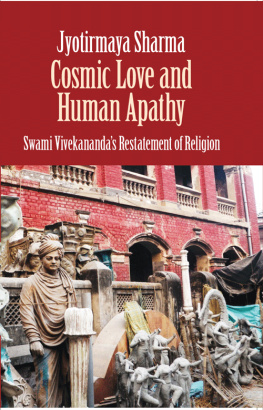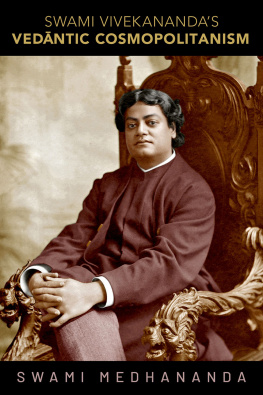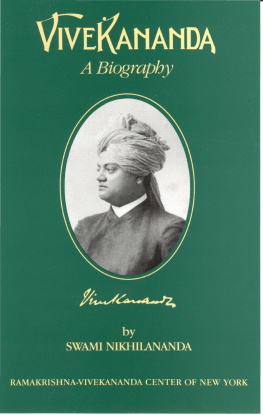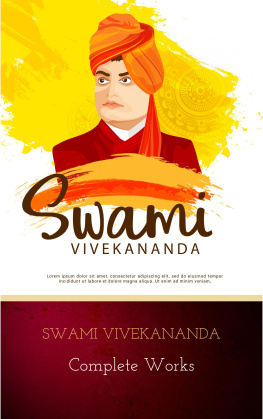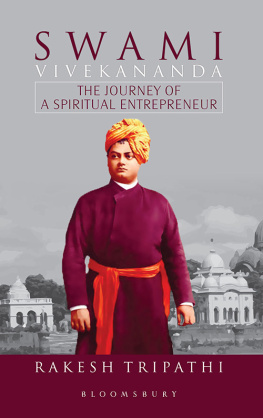
Swami Vivekananda
This Reader brings together some important writings from Swami Vivekanandas prolific output along with a scholarly assessment, placing Vivekananda in his context. In editing this volume Prof. Paranjape has done a great service to the academic community and broader public.
Gavin Flood, Professor of Hindu Studies and Comparative Religion University of Oxford Academic Director, Oxford Centre for Hindu Studies
Whatever our interest in Swami Vivekananda this anthology, well-organized with a general introduction along with helpful section introductions by Professor Makarand Paranjape, is now the indispensable resource. Swami Vivekananda would be the great har-monizer of our age. All those interested in questions of religion and science as well as modern Indian identity will treasure this anthology.
Stephen Phillips, Professor of Philosophy and Asian Studies University of Texas
The present volume makes a concerted effort to present this cyclonic monk by identifying different prominent themes, through a classification of a variety of genres of writing, and making a balanced representation. In the process Makarand Paranjape brilliantly succeeds in making available Vivekananda for further modern academic scrutiny.
A. Raghuramaraju, Professor of Philosophy University of Hyderabad
This elegant selection of passages from the magnificent body of work produced by Swami Vivekananda helps give the full picture of his genius Professor Paranjapes book serves to clarify and amplify this important voice, showing Vivekanandas ongoing relevance in the 21st century.
Chris Key Chapple, Doshi Professor of Indic and Comparative Theology, Department of Theological Studies Loyola Marymount University, Los Angeles
Swami Vivekananda
A Contemporary Reader
EDITOR
Makarand R. Paranjape

First published 2015 in India
by Routledge
912 Tolstoy House, 1517 Tolstoy Marg, Connaught Place, New Delhi 110 001
Simultaneously published in the UK
by Routledge
2 Park Square, Milton Park, Abingdon, Oxon OX14 4RN
Routledge is an imprint of the Taylor & Francis Group, an informa business
2015 Makarand R. Paranjape
Work on this book was supported by a grant from the Dharma Civilization Foundation, Los Angeles.
Typeset by
Glyph Graphics Private Limited
23, Khosla Complex
Vasundhara Enclave
Delhi 110 096
All rights reserved. No part of this book may be reproduced or utilised in any form or by any electronic, mechanical or other means, now known or hereafter invented, including photocopying and recording, or in any information storage and retrieval system without permission in writing from the publishers.
British Library Cataloguing-in-Publication Data
A catalogue record of this book is available from the British Library
ISBN 978-1-138-82206-1
Once again, for Prashantji,
who has understood the meaning of sadhana:

Manushyaanaam sahasreshu
kashchidyatati siddhaye;
Yatataamapi siddhaanaam
kashchinmaam vetti tattvatah.
Among thousands of human beings, perhaps only one strives for realization; even among those striving for realization, only one perhaps knows me truly.
Srimad Bhagavad Gita (7.3)

Dil zinda-o-bedaar agar ho to ba-tadreej
Bande ko ata karta hai chashme-nigraan aur
If the heart be alive and awakened, then a different vision is bestowed step-by-step upon the devotee.
Muhammad Iqbal
Contents
Part 5: Selections from Prose Writings
To Alasinga, 1894
I have felt greatly privileged to prepare this edition of Swami Vivekanandas works during the sesquicentennial anniversary celebrations of his birth. I undertook such a task not merely as a modern rationalistic or secularised intellectual, but as someone who sees the deep connection between the rise of Indian modernity and the religious reform movements of the nineteenth century. The aim of this anthology is to offer an authentic and persuasive contemporary account of Vivekanandas life and work by balancing these two aspects of his life the religious and the secular, the spiritual and the worldly, the deeply faith oriented and the intensely rational. Hence the title, A Contemporary Reader. This presentation of Vivekanandas lifework is aimed at selecting the most significant and representative texts from every major genre and phase of his enormously productive, albeit brief, life.
While Vivekananda is one of modern Indias most anthologised figures, his words have been collected over and over again largely by the organisations that he himself founded, the Ramakrishna Math and Mission. These, under the banner of the Advaita Ashrama, have over the years published several editions of the only available and exhaustive collection of his writings, the Complete Works of Swami Vivekananda. Extending into nine volumes but still not finished, they embody the most extensive compilation of Vivekanandas writings.
The original manuscripts of Vivekananda are, however, mostly unavailable or closed to the public. So the comparison of the published works with their originals or the publication of an independently edited edition of Vivekanandas works is as yet not possible. The monks of the Order no doubt have done their best to preserve, collect, and collate all of Swamijis writings. This is a Herculean effort involving hundreds of men and women, spread across at least three continents. And yet, the present edition of the Complete Works, for reasons that I shall give, is not without its flaws and problems. For instance, the Complete Works does not adequately provide the original circumstances, historical details, and information about the source of each of its contents. Except for the speeches at the Parliament of Religions, which are clearly identified, the items in the collection seem to be all jumbled up in a haphazard and overlapping manner. The arrangement is neither consistently chronological, thematic nor generic.
Several other, smaller anthologies mostly brought out by the Mission are in the nature of compilations for more specific purposes, such as Swami Vivekanandas Message to the Youth or Swami Vivekananda on Women, Swami Vivekananda on Indias Problems, and so on. These selections tend to decontextualise Swamijis words by removing them from the specific historical occasion on which they were uttered. They are in the nature of inspirational booklets and perhaps effective to that extent, but they do not give us an accurate picture of what Vivekananda said to whom, where, why, and how what he said may fit into his overall career as a thinker or activist.
The Complete Works, which are source of all these anthologies, including the present text, pose some special challenges. They were published over a period of time, first in four volumes; then the fifth and sixth were added; the seventh volume appeared after a long gap. Then the eighth and, most recently, the ninth volumes were published. The Complete Works occupy about 5,000 pages, with the arrangement of the contents dictated more by reasons of convenience, availability of material, or the order of the discovery of the writings rather than any well-thought out order or plan. There seems to be neither a clear written policy nor agenda of publication. Their largest portion consists of transcripts of lectures and talks that Vivekananda gave. These occupy 2,000 pages or 40 per cent of the total contents, spread across several volumes. What he wrote himself only takes up some 650 pages or a mere 13 per cent of the space. This includes his English and Bengali writings, which are in different sections. His letters, again, occurring in several volumes in different series, take up around 1,000 pages or 20 per cent of the total. The rest of the material, about 1,300 pages or 26 per cent was not even written by Vivekananda. It consists of lecture notes and conversations (about 20 per cent), newspaper reports and interviews (about 6 per cent). The different genres that make up the
Next page

